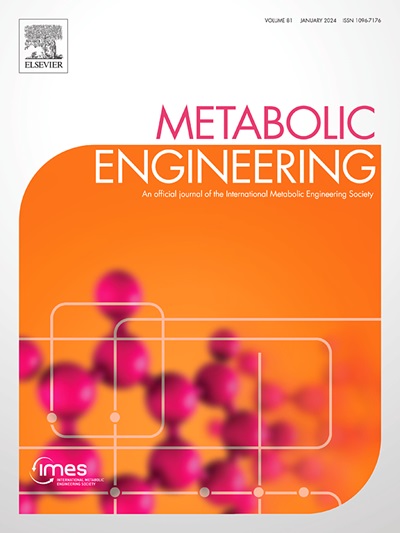大肠杆菌的进化辅助工程可通过丝氨酸苏氨酸循环在环境二氧化碳条件下利用甲酸进行生长。
IF 6.8
1区 生物学
Q1 BIOTECHNOLOGY & APPLIED MICROBIOLOGY
引用次数: 0
摘要
大气中的二氧化碳会导致全球变暖和气候变化,对地球上的生命构成重大威胁。另一方面,它也可以被视为一种资源,其规模足以建立循环碳经济。因此,捕获二氧化碳并将其转化为还原一碳(C1)化合物(如甲酸)的技术正在快速发展和改进。在创建可持续生物生产平台这一理念的推动下,天然和合成的 C1 利用途径被设计到与工业相关的微生物中。在生物体内实现合成 C1 同化循环是一项前景广阔但极具挑战性的工作。在这里,我们在大肠杆菌中设计了合成 C1 同化循环的丝氨酸苏氨酸循环,以实现在甲酸上的生长。我们在量身定制的选择菌株中采用分步工程方法,并结合适应性实验室进化实验,实现了该生物的格式营养生长。通过全基因组测序和逆向工程,我们确定了与途径活性相关的关键突变。在这项工作中创建的丝氨酸苏氨酸循环菌株使用甲酸作为碳源和能源,可以在环境二氧化碳培养条件下生长。这项工作为在异养微生物中设计复杂的 C1 同化循环树立了榜样。本文章由计算机程序翻译,如有差异,请以英文原文为准。
Evolution-assisted engineering of E. coli enables growth on formic acid at ambient CO2 via the Serine Threonine Cycle
Atmospheric CO2 poses a major threat to life on Earth by causing global warming and climate change. On the other hand, it can be considered as a resource that is scalable enough to establish a circular carbon economy. Accordingly, technologies to capture and convert CO2 into reduced one-carbon (C1) compounds (e.g. formic acid) are developing and improving fast. Driven by the idea of creating sustainable bioproduction platforms, natural and synthetic C1-utilization pathways are engineered into industrially relevant microbes. The realization of synthetic C1-assimilation cycles in living organisms is a promising but challenging endeavour. Here, we engineer the Serine Threonine Cycle, a synthetic C1-assimilation cycle in Escherichia coli to achieve growth on formic acid. Our stepwise engineering approach in tailored selection strains combined with adaptive laboratory evolution experiments enabled formatotrophic growth of the organism. Whole genome sequencing and reverse engineering allowed us to determine the key mutations linked to pathway activity. The Serine Threonine Cycle strains created in this work use formic acid as sole carbon and energy source and can grow at ambient CO2 cultivation conditions. This work sets an example for the engineering of complex C1-assimilation cycles in heterotrophic microbes.
求助全文
通过发布文献求助,成功后即可免费获取论文全文。
去求助
来源期刊

Metabolic engineering
工程技术-生物工程与应用微生物
CiteScore
15.60
自引率
6.00%
发文量
140
审稿时长
44 days
期刊介绍:
Metabolic Engineering (MBE) is a journal that focuses on publishing original research papers on the directed modulation of metabolic pathways for metabolite overproduction or the enhancement of cellular properties. It welcomes papers that describe the engineering of native pathways and the synthesis of heterologous pathways to convert microorganisms into microbial cell factories. The journal covers experimental, computational, and modeling approaches for understanding metabolic pathways and manipulating them through genetic, media, or environmental means. Effective exploration of metabolic pathways necessitates the use of molecular biology and biochemistry methods, as well as engineering techniques for modeling and data analysis. MBE serves as a platform for interdisciplinary research in fields such as biochemistry, molecular biology, applied microbiology, cellular physiology, cellular nutrition in health and disease, and biochemical engineering. The journal publishes various types of papers, including original research papers and review papers. It is indexed and abstracted in databases such as Scopus, Embase, EMBiology, Current Contents - Life Sciences and Clinical Medicine, Science Citation Index, PubMed/Medline, CAS and Biotechnology Citation Index.
 求助内容:
求助内容: 应助结果提醒方式:
应助结果提醒方式:


